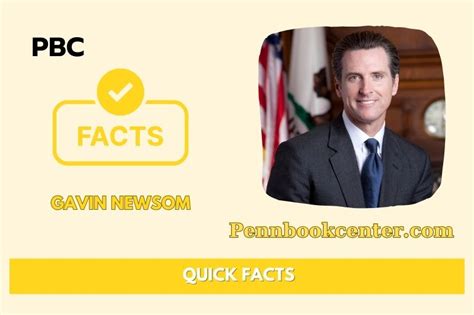The notion of truth, particularly when it involves public figures, is a complex and multifaceted concept. Gavin Newsom, the current Governor of California, has been a subject of both praise and criticism throughout his political career. To uncover the facts about Gavin Newsom, it’s essential to delve into his background, policy decisions, and the impact of his governance on the state of California.
Early Life and Career
Gavin Newsom was born on October 10, 1967, in San Francisco, California. His early life and career are marked by a blend of politics and entrepreneurship. Newsom’s entry into politics was significantly influenced by his appointment by Willie Brown, the then-Mayor of San Francisco, to the city’s Parking and Traffic Commission in 1996. This appointment paved the way for his political ascent, including his election as the Mayor of San Francisco in 2003, a position he held until 2011.
Policy Initiatives and Governance
As the Mayor of San Francisco, Newsom was known for his progressive policies, including his decision in 2004 to direct the San Francisco city clerk to issue marriage licenses to same-sex couples, a move that was controversial at the time but marked a significant step in the fight for LGBTQ+ rights. This action not only highlighted Newsom’s stance on social issues but also demonstrated his willingness to challenge existing laws and conventions.
Newsom’s governance style and policy initiatives have continued to reflect a progressive agenda. Upon becoming the Governor of California in 2019, he focused on issues such as housing affordability, education, and healthcare. One of his notable actions was the signing of an executive order to establish a framework for California to independently set its own emissions and fuel efficiency standards for vehicles, in response to the federal government’s plans to roll back such standards. This move underscored his commitment to environmental protection and his willingness to confront federal policies deemed not in California’s best interests.
Controversies and Criticisms
Like many political figures, Newsom has not been immune to controversies and criticisms. One of the significant challenges he faced was the COVID-19 pandemic, during which his handling of the crisis, including lockdowns and vaccination mandates, drew both support and criticism. Critics argued that his policies were too restrictive, harming businesses and personal freedoms, while supporters praised his proactive approach to mitigating the spread of the virus.
Another point of contention has been his stance on issues related to homelessness and housing affordability. Despite allocating significant funds and proposing various initiatives to address these problems, critics argue that the pace of progress has been too slow, and the issues persist as major challenges for the state.
Economic Policies and Impact
Newsom’s economic policies have aimed to balance the needs of various stakeholders, including businesses, workers, and the environment. California, under his governance, has continued to be a hub for innovation and technology, with Silicon Valley remaining a significant contributor to the state’s and the nation’s economy. However, the state also faces challenges such as high costs of living, which can deter businesses and individuals from relocating or staying in California.
Conclusion
Uncovering the truth about Gavin Newsom involves navigating a complex landscape of political achievements, policy decisions, and the multifaceted challenges of governing a state as diverse and populous as California. While his tenure has been marked by significant progressive reforms and initiatives, it has also been subject to criticisms and controversies. The assessment of his governance ultimately depends on one’s values and priorities, reflecting the broader polarization in American politics. As the political landscape continues to evolve, the impact of Newsom’s policies and decisions will remain a subject of discussion and analysis.
FAQ Section
What are some of Gavin Newsom's notable policy achievements?
+Gavin Newsom has been instrumental in pushing for progressive policies, including same-sex marriage rights, environmental protection initiatives, and efforts to address housing affordability and homelessness in California.
How has Newsom handled the COVID-19 pandemic in California?
+Newsom implemented various measures to combat the pandemic, including lockdowns, vaccination mandates, and economic support for affected businesses and individuals. His approach has been both praised for its proactive nature and criticized for its impact on personal freedoms and the economy.
What are the criticisms of Newsom's governance, particularly regarding homelessness and housing affordability?
+Critics argue that despite significant funding allocations and policy initiatives, the pace of progress in addressing homelessness and housing affordability has been too slow, with these issues remaining major challenges for California.
Expert Insights
Gavin Newsom's tenure as Governor of California reflects the broader challenges and opportunities of governance in the 21st century. His policies and decisions offer a window into the complex interplay between political ideology, economic realities, and social needs. As the state continues to evolve, the impact and legacy of his governance will be subjects of ongoing debate and analysis.
Comparative Analysis
When comparing Gavin Newsom’s governance with that of other political leaders, it’s essential to consider the unique context and challenges of California. The state’s diverse population, robust economy, and progressive political leaning set it apart from other regions in the United States. Newsom’s approach to addressing the state’s challenges, while drawing criticism, also reflects a commitment to progressive values and a willingness to innovate and challenge status quo policies.
Historical Context
Understanding Gavin Newsom’s political trajectory and policy decisions requires a historical context that acknowledges the evolution of political and social issues in California. From his early days as Mayor of San Francisco to his current role as Governor, Newsom has navigated a shifting political landscape, marked by changing public attitudes towards issues like LGBTQ+ rights, environmental protection, and healthcare access. This context highlights the dynamic nature of politics and the need for leaders to adapt and evolve in response to changing societal needs and values.
Future Trends Projection
As California and the United States look towards the future, the policies and decisions made by leaders like Gavin Newsom will play a significant role in shaping the trajectory of the state and the nation. The challenges of climate change, economic inequality, and social justice will require innovative and proactive governance. Newsom’s commitment to addressing these issues, though imperfect and subject to criticism, reflects a broader recognition of the need for progressive and adaptive leadership in the face of evolving challenges.
Decision Framework
For those seeking to understand or evaluate Gavin Newsom’s governance, a decision framework that considers multiple factors is essential. This includes examining the impact of his policies on different stakeholders, assessing the alignment of his decisions with stated goals and values, and evaluating the effectiveness of his governance style in addressing the complex challenges facing California. By adopting such a framework, individuals can develop a nuanced understanding of Newsom’s leadership and its implications for the future of the state.
Practical Application Guide
In translating the insights from Gavin Newsom’s governance into practical applications, whether in political, social, or economic contexts, it’s crucial to consider the specific challenges and opportunities of one’s own environment. This may involve assessing how policies aimed at addressing issues like housing affordability or environmental protection could be adapted or scaled for different regions or communities. By applying these lessons in a thoughtful and context-sensitive manner, individuals and organizations can contribute to more effective and equitable governance practices.
Key Takeaways
Gavin Newsom's governance of California offers valuable insights into the complexities of modern political leadership. His commitment to progressive policies, his willingness to challenge existing norms, and his efforts to address the state's most pressing challenges serve as a reflection of the evolving nature of politics and governance.
Step-by-Step Analysis
- Understanding Context: Begin by understanding the historical, social, and economic context in which Gavin Newsom operates.
- Policy Evaluation: Evaluate the impact and effectiveness of Newsom’s policies, considering both their intended and unintended consequences.
- Comparative Perspective: Compare Newsom’s governance style and policy decisions with those of other leaders, both within the United States and internationally.
- Future Implications: Consider the potential long-term implications of Newsom’s decisions for California and the broader political landscape.
- Practical Applications: Reflect on how the insights from Newsom’s governance could be applied in other contexts, adapting policies and approaches to suit different challenges and needs.
Pro-Con Analysis
Pros: - Newsom’s progressive policies have advanced rights and protections for marginalized communities. - His environmental initiatives aim to make California a leader in combating climate change. - Efforts to address housing affordability and homelessness, though challenging, demonstrate a commitment to social welfare.
Cons: - Criticisms of his handling of the COVID-19 pandemic, particularly regarding personal freedoms and economic impacts. - The pace of progress on issues like homelessness has been slower than anticipated, prompting criticism. - Some policies, such as those related to environmental protection, have faced opposition from certain industries and political groups.
Thought Experiment Framework
Imagine a scenario where California’s economic, social, and environmental challenges were tackled through a completely different governance model. How might such a model address the complexities of housing affordability, environmental degradation, and social inequality? Considering alternative governance structures and policies can provide a thought-provoking framework for evaluating the effectiveness of Newsom’s approach and imagining potential futures for the state.
Data Visualization Description
Visualizing the data related to Gavin Newsom’s governance, such as the impact of his policies on homelessness rates, economic indicators, and environmental metrics, can provide valuable insights into the effectiveness of his decisions. By representing complex data in a clear and accessible manner, individuals can better understand the challenges and opportunities facing California and the role of governance in addressing these issues.
Natural Storytelling Elements
The story of Gavin Newsom’s political career is one of progression, from his early days as a businessman and politician in San Francisco to his current role as Governor of California. This narrative is marked by significant moments of challenge and opportunity, including his decision to issue same-sex marriage licenses and his response to the COVID-19 pandemic. Through these stories, one can gain a deeper understanding of Newsom’s values, his governance style, and the complexities of political leadership in the modern era.
Scenario-Based Examples
Consider a scenario where a small business owner in California is struggling to maintain operations due to the high cost of living and stringent environmental regulations. How might Gavin Newsom’s policies, intended to balance economic growth with social and environmental protection, impact this individual’s situation? Scenario-based examples can help illustrate the practical implications of Newsom’s governance on the lives of Californians and the state’s economy.
Historical Context Segments
Gavin Newsom’s political trajectory and policy decisions are deeply intertwined with the historical context of California and the United States. Understanding the evolution of political and social issues, from the fight for LGBTQ+ rights to the current challenges of climate change, provides a crucial backdrop for evaluating Newsom’s governance. This historical perspective highlights the dynamic nature of politics and the need for leaders to adapt and innovate in response to changing societal needs and values.
Future Implications Sections
As California looks towards the future, the implications of Gavin Newsom’s policies and decisions will continue to unfold. The state’s efforts to combat climate change, address social inequality, and navigate the complexities of the global economy will set a precedent for other regions and countries. Considering these future implications, individuals can better understand the significance of Newsom’s governance and its potential impact on the broader political and social landscape.


